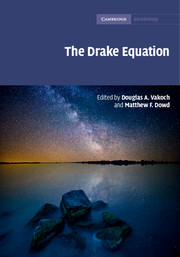Book contents
- The Drake EquationEstimating the Prevalence of Extraterrestrial Life through the Ages
- Cambridge Astrobiology
- The Drake Equation
- Copyright page
- Dedication
- Contents
- Contributors
- Foreword
- Preface
- Book part
- Introduction
- 1 Rate of formation of stars suitable for the development of intelligent life, R*, pre-1961
- 2 Rate of formation of stars suitable for the development of intelligent life, R*, 1961 to the present
- 3 Fraction of stars with planetary systems, fp, pre-1961
- 4 Fraction of stars with planetary systems, fp, 1961 to the present
- 5 Number of planets, per solar system, with an environment suitable for life, ne, pre-1961
- 6 Number of planets, per solar system, with an environment suitable for life, ne, 1961 to the present
- 7 Fraction of suitable planets on which life actually appears, fl, pre-1961
- 8 Fraction of suitable planets on which life actually appears, fl, 1961 to the present
- 9 Fraction of life-bearing planets on which intelligent life emerges, fi, pre-1961
- 10 Fraction of life-bearing planets on which intelligent life emerges, fi, 1961 to the present
- 11 Fraction of civilizations that develop a technology that releases detectable signs of their existence into space, fc, pre-1961
- 12 Fraction of civilizations that develop a technology that releases detectable signs of their existence into space, fc, 1961 to the present
- 13 Length of time such civilizations release detectable signals into space, L, pre-1961
- 14 Length of time such civilizations release detectable signals into space, L, 1961 to the present
- Afterword
- Index
- References
Afterword
Published online by Cambridge University Press: 05 July 2015
- The Drake EquationEstimating the Prevalence of Extraterrestrial Life through the Ages
- Cambridge Astrobiology
- The Drake Equation
- Copyright page
- Dedication
- Contents
- Contributors
- Foreword
- Preface
- Book part
- Introduction
- 1 Rate of formation of stars suitable for the development of intelligent life, R*, pre-1961
- 2 Rate of formation of stars suitable for the development of intelligent life, R*, 1961 to the present
- 3 Fraction of stars with planetary systems, fp, pre-1961
- 4 Fraction of stars with planetary systems, fp, 1961 to the present
- 5 Number of planets, per solar system, with an environment suitable for life, ne, pre-1961
- 6 Number of planets, per solar system, with an environment suitable for life, ne, 1961 to the present
- 7 Fraction of suitable planets on which life actually appears, fl, pre-1961
- 8 Fraction of suitable planets on which life actually appears, fl, 1961 to the present
- 9 Fraction of life-bearing planets on which intelligent life emerges, fi, pre-1961
- 10 Fraction of life-bearing planets on which intelligent life emerges, fi, 1961 to the present
- 11 Fraction of civilizations that develop a technology that releases detectable signs of their existence into space, fc, pre-1961
- 12 Fraction of civilizations that develop a technology that releases detectable signs of their existence into space, fc, 1961 to the present
- 13 Length of time such civilizations release detectable signals into space, L, pre-1961
- 14 Length of time such civilizations release detectable signals into space, L, 1961 to the present
- Afterword
- Index
- References
Summary
In the five decades since Frank Drake formulated his eponymous equation, our understanding of astrophysics and planetary science has advanced enormously. The first three terms of the equation refer to factors that are now known with reasonable precision, due in no small part to the discovery of enough extrasolar planets for meaningful statistics to be developed. Unfortunately, this progress has not been matched by a similar leap in understanding of the remaining factors – the biological ones. In particular, the probability of life emerging on an Earth-like planet, fl, remains completely unknown. In the 1960s and 1970s, most scientists assumed that the origin of life was a freak event, an accident of chemistry of such low probability that it would be unlikely to have occurred twice within the observable universe. Today, however, many distinguished scientists express a belief that life will be almost inevitable on a rocky planet with liquid water – a “cosmic imperative,” to use the evocative term of Christian de Duve. But this sentiment is based on little more than fashion. One may assign a probability to a process only after the mechanism that brings about that process is known. As we have little knowledge of how a nonliving mix of chemicals is transformed into a living thing, we can say almost nothing about its likelihood. Indeed, it is easy to imagine plausible constraints on the chemical pathway to life that would make its successful passage infinitesimally small. In the case of the fifth term in the Drake Equation – the probability that intelligence will evolve if life gets going – at least we have a well-understood mechanism (Darwinian evolution) on which to base a probability estimate (though it still remains deeply problematic). The same is true of the remaining terms. Thus, the uncertainty in the number of communicating civilizations in the galaxy, N, is overwhelmingly dominated by fl. The uncertainty would be immediately removed, however, if a second, independent sample of life was discovered. The best current hope for establishing a value of fl close to one would be the discovery of a “shadow biosphere” on Earth or a breakthrough in understanding the rules governing the organization of information in complex chemical networks.
- Type
- Chapter
- Information
- The Drake EquationEstimating the Prevalence of Extraterrestrial Life through the Ages, pp. 298 - 311Publisher: Cambridge University PressPrint publication year: 2015

